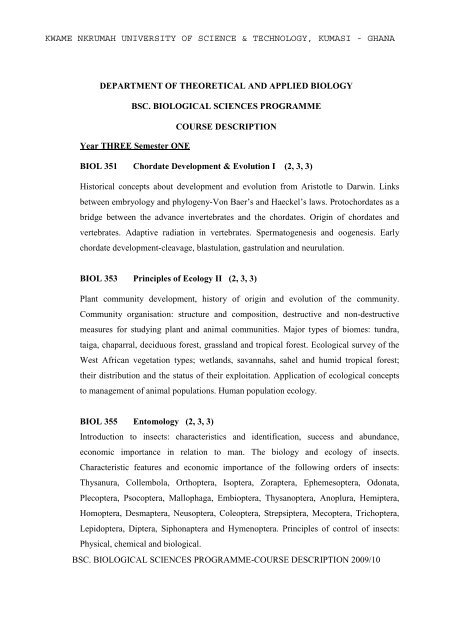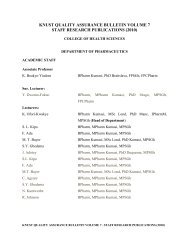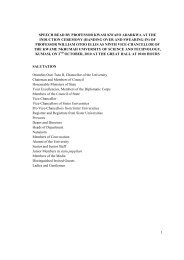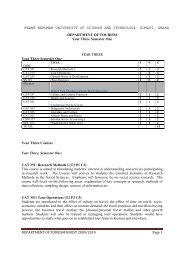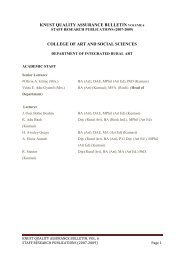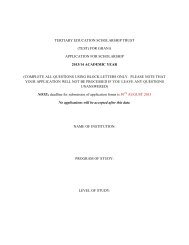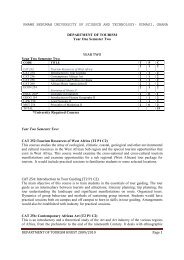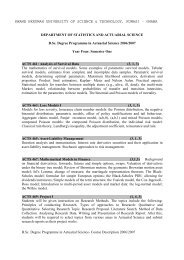kwame nkrumah university of science & technology, kumasi - ghana
kwame nkrumah university of science & technology, kumasi - ghana
kwame nkrumah university of science & technology, kumasi - ghana
Create successful ePaper yourself
Turn your PDF publications into a flip-book with our unique Google optimized e-Paper software.
DEPARTMENT OF THEORETICAL AND APPLIED BIOLOGYBSC. BIOLOGICAL SCIENCES PROGRAMMECOURSE DESCRIPTIONYear THREE Semester ONEBIOL 351 Chordate Development & Evolution I (2, 3, 3)Historical concepts about development and evolution from Aristotle to Darwin. Linksbetween embryology and phylogeny-Von Baer’s and Haeckel’s laws. Protochordates as abridge between the advance invertebrates and the chordates. Origin <strong>of</strong> chordates andvertebrates. Adaptive radiation in vertebrates. Spermatogenesis and oogenesis. Earlychordate development-cleavage, blastulation, gastrulation and neurulation.BIOL 353 Principles <strong>of</strong> Ecology II (2, 3, 3)Plant community development, history <strong>of</strong> origin and evolution <strong>of</strong> the community.Community organisation: structure and composition, destructive and non-destructivemeasures for studying plant and animal communities. Major types <strong>of</strong> biomes: tundra,taiga, chaparral, deciduous forest, grassland and tropical forest. Ecological survey <strong>of</strong> theWest African vegetation types; wetlands, savannahs, sahel and humid tropical forest;their distribution and the status <strong>of</strong> their exploitation. Application <strong>of</strong> ecological conceptsto management <strong>of</strong> animal populations. Human population ecology.BIOL 355 Entomology (2, 3, 3)Introduction to insects: characteristics and identification, success and abundance,economic importance in relation to man. The biology and ecology <strong>of</strong> insects.Characteristic features and economic importance <strong>of</strong> the following orders <strong>of</strong> insects:Thysanura, Collembola, Orthoptera, Isoptera, Zoraptera, Ephemesoptera, Odonata,Plecoptera, Psocoptera, Mallophaga, Embioptera, Thysanoptera, Anoplura, Hemiptera,Homoptera, Desmaptera, Neusoptera, Coleoptera, Strepsiptera, Mecoptera, Trichoptera,Lepidoptera, Diptera, Siphonaptera and Hymenoptera. Principles <strong>of</strong> control <strong>of</strong> insects:Physical, chemical and biological.BSC. BIOLOGICAL SCIENCES PROGRAMME-COURSE DESCRIPTION 2009/10
BCHEM 365 Biophysics (3, 0, 3)Sedimentation techniques; theory, forces involved and types <strong>of</strong> sedimentation techniques.Applications <strong>of</strong> sedimentation. Electrophoresis - theory and equipment used.Applications <strong>of</strong> electrophoresis. Electrical phenomena and electro-chemistry.BCHEM 471 Immunology (3, 0, 3)Introduction to the immune response: Different types <strong>of</strong> immunity. Cells and tissues <strong>of</strong>the immune system. Antibodies: Generation <strong>of</strong> antibody diversity: Immunoglobins genestricture and rearrangement. Antibody structure and function. Measurement andProduction <strong>of</strong> antibodies in vitro, monoclonal antibodies.Uses <strong>of</strong> antibodies in modern research. Immune response: Production <strong>of</strong> antibodies invivo: B-cells. Killing mechanisms I:- The complement system. Recognition <strong>of</strong> Target:The Major Histocompatibility Complex. Killing mechanisms II:- T-cells and the T-cellreceptor. How the system deals with immune challenges eg. bacteria, viruses andparasites. Failure <strong>of</strong> the immune response: Immunodeficiencies and autoimmunity.Transplantation and HIV.MATH 153 Statistical Methods I (2, 0, 2)Introduction to Basic concepts; notation, tables and charts and Organisation <strong>of</strong> Data.Measures <strong>of</strong> location: Mean, Median, Mode, Percentile for grouped and ungrouped dataand Graphical estimation. Measures <strong>of</strong> dispersion: ranges, mean, deviation, variance andstandard deviation skewness and kurtosis. Probability, probability distributions, randomvariables and the normal distribution.ElectivesLAW 151 Law <strong>of</strong> Contract I (3, 0, 3)Nature <strong>of</strong> contract; sources <strong>of</strong> law, concept <strong>of</strong> bargain and classification. Formation <strong>of</strong>contract; <strong>of</strong>fer and acceptance, consideration, intention to create legal relations. ContentsBSC. BIOLOGICAL SCIENCES PROGRAMME-COURSE DESCRIPTION 2009/10
<strong>of</strong> contract, terms, representation, excluding and limiting terms and fundamental breach<strong>of</strong> terms. Capacity; infants, illiterates, co-operations, mental patients and drunkenpersons.MGT 471 Principles <strong>of</strong> Management I (3, 0, 3)The objective <strong>of</strong> this course is to equip students. Without basic knowledge inmanagement, with the tools <strong>of</strong> decision-making, organization and management <strong>of</strong>decision-making, organization and management <strong>of</strong> firms and organization. It covers:Nature and scope <strong>of</strong> management; managerial functions, organizational theories; goals <strong>of</strong>business organization – economic and social responsibilities <strong>of</strong> management; decisionmakingtechniques and influence; nature and types <strong>of</strong> organization and their implicationsfor organizational administration.BSC. BIOLOGICAL SCIENCES PROGRAMME-COURSE DESCRIPTION 2009/10


